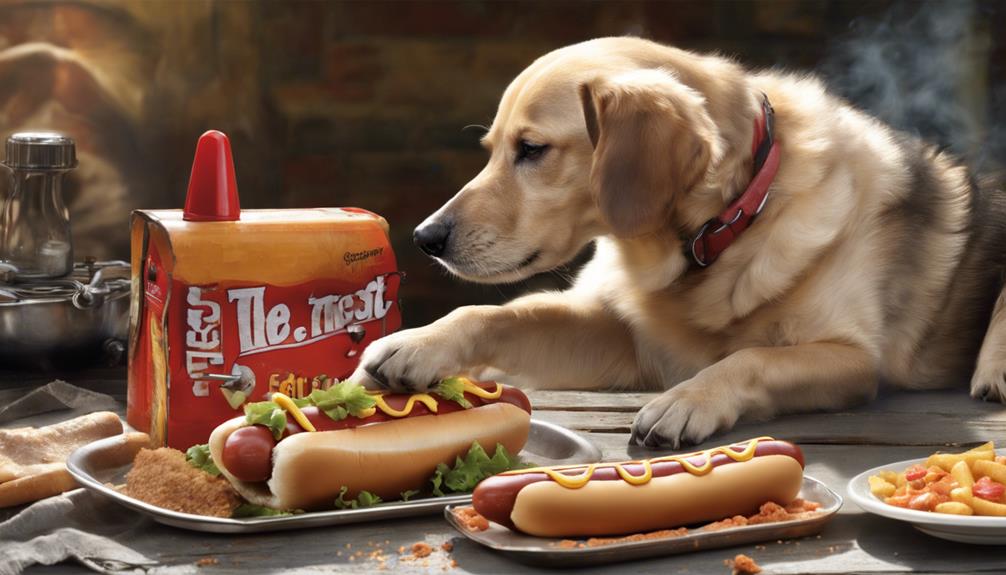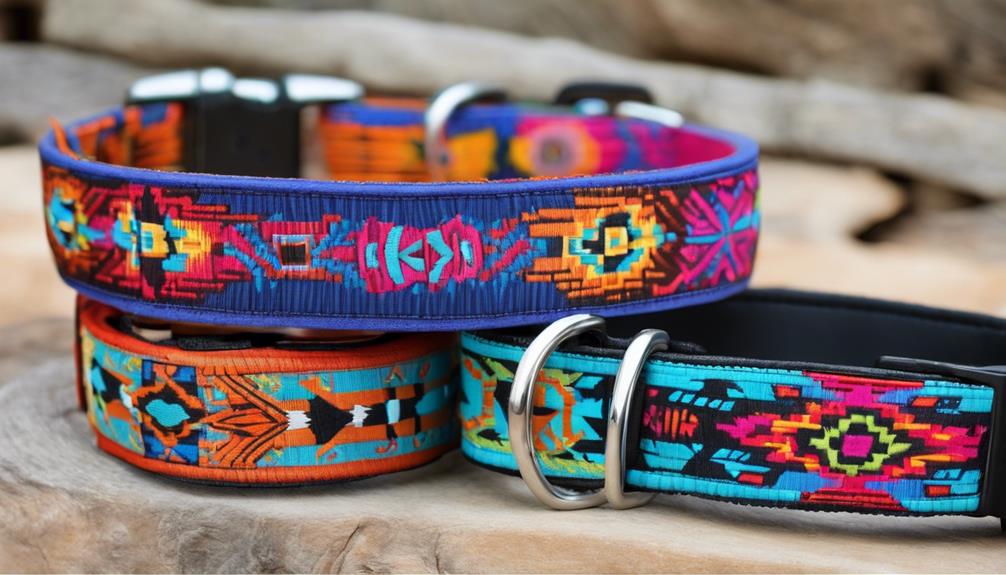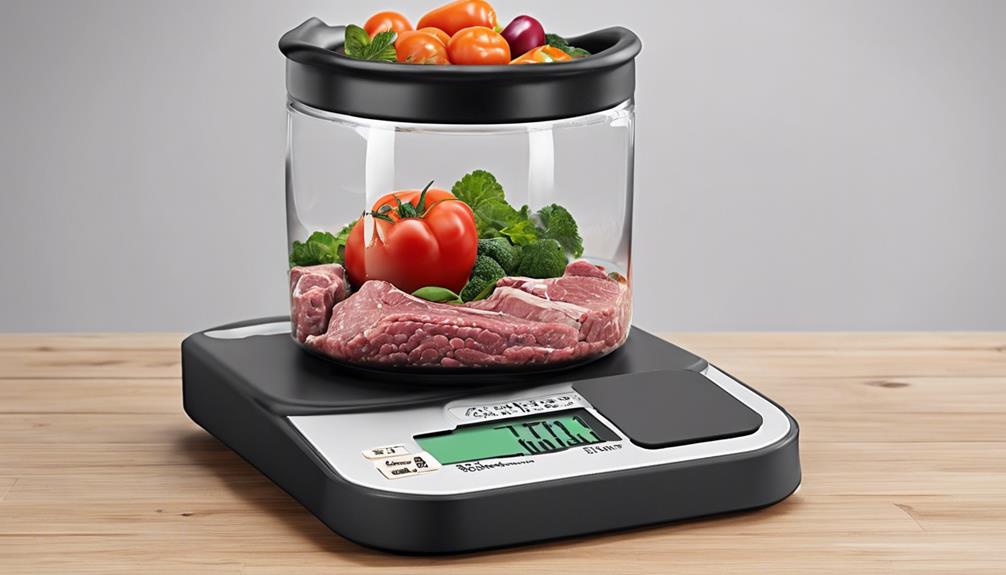When giving hot dogs to dogs, it is important to remember to cut them into small, bite-sized pieces. Stick to plain, boiled, or grilled hot dogs without extra oil or seasonings. Choose lean meat options like chicken or turkey. Monitor the portion size based on your dog’s weight. Use hot dogs as occasional treats during training. For safer toppings, opt for cooked meats or veggies and avoid high-sodium or toxic options. Limit hot dog treats to 10% of the dog’s daily calories. For more tips on keeping your pup safe when enjoying hot dogs, continue exploring our advice.
Key Takeaways
- Cut hot dogs into small, bite-sized pieces for safe consumption.
- Choose lean meat hot dogs without harmful ingredients like garlic or onion.
- Monitor portion size based on your dog's weight to prevent overfeeding.
- Serve plain, boiled, or grilled hot dogs without added oils or seasonings.
- Use hot dogs as occasional treats, not a regular part of their diet.
Risks of Feeding Hot Dogs to Dogs
Feeding hot dogs to dogs poses serious health risks due to their high fat, salt content, and potentially toxic ingredients like garlic and onion powder. Hot dogs aren't just a delicious treat for us; they can be harmful to our furry friends.
These processed sausages are high in salt, sometimes containing more than 500 mg per hot dog, which surpasses a dog's daily salt intake limit. Additionally, ingredients like garlic and onion powder, commonly found in hot dogs, are toxic for dogs and can lead to health issues if consumed.
Excessive sodium from hot dogs can result in dehydration and high blood pressure in our canine companions. It's important to be aware of these risks and avoid feeding hot dogs to dogs to keep them healthy and happy. Remember, our pups' well-being is our top priority, so let's choose their treats wisely.
Safe Hot Dog Serving Methods
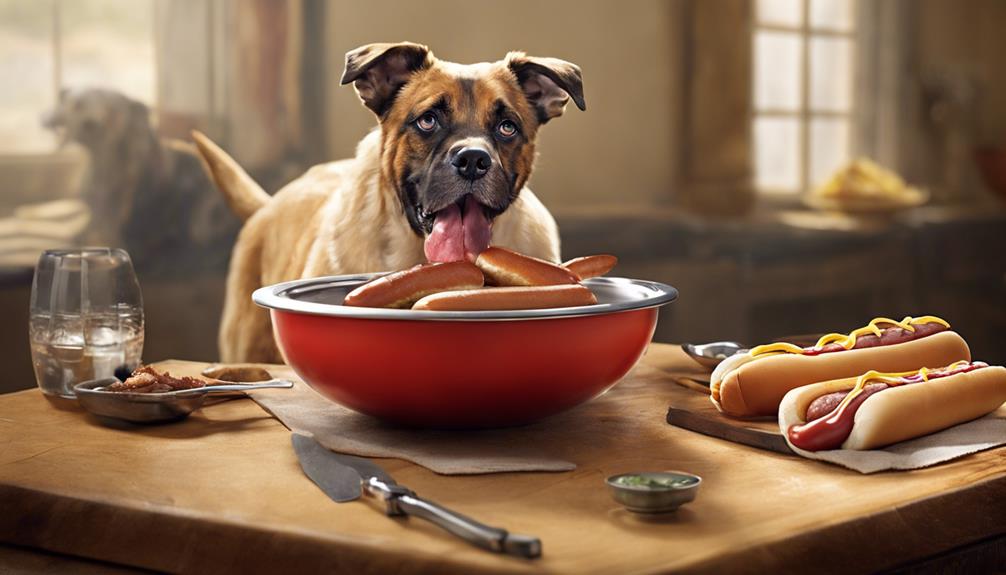
When serving hot dogs to dogs, it is essential to cut them into small, bite-sized pieces to prevent choking hazards. Serve plain, boiled, or grilled hot dogs without any added oil, seasonings, or toppings. Opt for lean meat hot dogs like chicken or turkey to reduce fat content. Monitor the portion size based on the dog's weight to prevent overfeeding. Use hot dogs as occasional treats during training sessions to maintain a balanced diet for dogs. Below is a table summarizing safe hot dog serving methods for your furry friend:
| Safe Hot Dog Serving Methods | Description |
|---|---|
| Cut Into Small Pieces | Prevents choking hazards |
| Use Lean Meat Hot Dogs | Reduces fat content |
| Monitor Portion Size | Prevents overfeeding |
| Serve Plain Hot Dogs | Avoids toxic ingredients |
Types of Hot Dogs for Dogs

When choosing hot dogs for your furry friend, opt for options made from beef, turkey, chicken, or plant-based ingredients.
Make sure the hot dogs are free of onions, garlic, and spices to prevent any toxicity in dogs.
Keeping the hot dogs lean, low in sodium, and preservative-free can contribute to a healthier diet for your canine companion.
Dog-Friendly Hot Dog Options
Exploring the variety of dog-friendly hot dog options available can provide pet owners with safe and enjoyable choices for their canine companions. When selecting hot dogs for dogs, opt for lean meats such as beef, turkey, chicken, or plant-based ingredients.
Make sure the hot dogs are low sodium, preservative-free, and free of onions, garlic, and spices to prevent any potential health issues. Boiled or grilled hot dogs are the best choices for dogs, as they're easier to digest and safer for consumption.
Safe Hot Dog Toppings
To ensure the safety of our furry friends when it comes to enjoying hot dogs, it's important to consider the types of safe toppings that can be added to their meal. High-sodium toppings like bacon or cheese should be used sparingly, as excessive salt intake can be harmful to dogs.
Opt for safer options such as plain hot dogs without toppings, or consider adding a small amount of ketchup if your pup enjoys it, keeping in mind its sugar content. Mustard should be avoided entirely, as mustard seeds are toxic to dogs.
Additionally, never include onions as they're toxic to our canine companions. When choosing toppings for your dog's hot dog treat, always prioritize their safety and well-being over flavor.
Portion Control Tips
How can we guarantee our furry friends stay healthy while enjoying hot dogs? When it comes to portion control tips for dogs, choose hot dogs made of lean meats such as beef, turkey, chicken, or plant-based options. Make sure the hot dogs are low in sodium and free of preservatives to reduce health risks. Adjust the serving size based on your dog's weight, offering smaller pieces for smaller dogs. To prepare hot dogs for your pet, opt for boiled or grilled options without oil and seasonings. Use the table below as a quick reference guide for selecting the right type of hot dogs for your dog.
| Hot Dog Type | Lean Meats | Low Sodium | Preservative-Free | Preparation |
|---|---|---|---|---|
| Beef | ✔️ | ✔️ | ✔️ | Boiled/Grilled |
| Turkey | ✔️ | ✔️ | ✔️ | Boiled/Grilled |
| Chicken | ✔️ | ✔️ | ✔️ | Boiled/Grilled |
| Plant-Based | ✔️ | ✔️ | ✔️ | Boiled/Grilled |
Hot Dog Toppings for Dogs
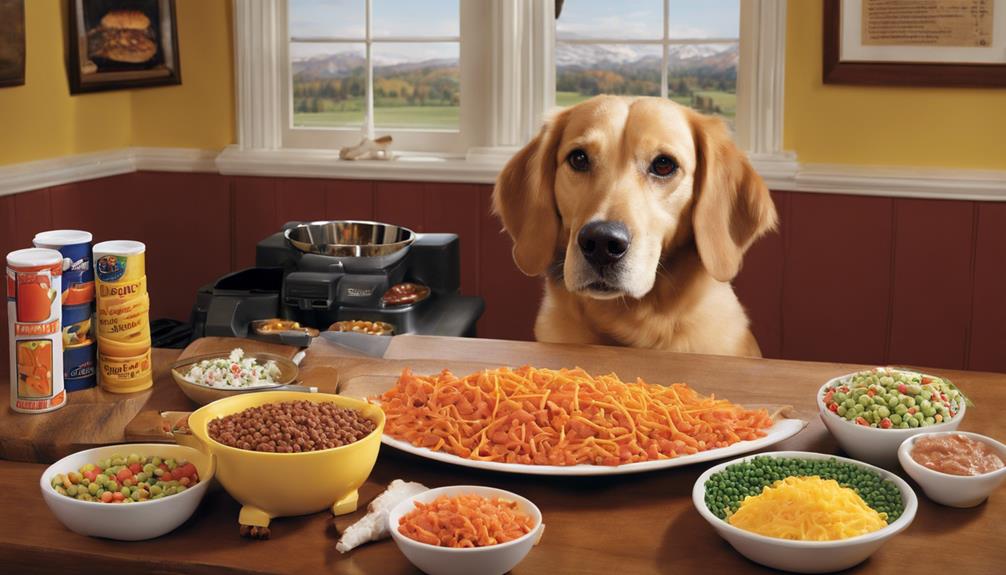
When considering hot dog toppings for dogs, it's important to be cautious of their ingredients to ensure your furry friend stays safe and healthy. Some toppings like ketchup can be safe in small amounts, but due to its high sugar content, it should be monitored. Mustard, on the other hand, should be avoided as mustard seeds are toxic to dogs. Additionally, onions are extremely toxic to dogs and should never be fed to them as they can lead to serious health complications. While bread is generally safe for dogs unless they've wheat or gluten sensitivities, it doesn't offer much by way of nutritional value.
To keep your dog safe and healthy, it's best to stick to dog-friendly toppings like plain cooked meat or vegetables. These options aren't only safer but also provide more nutritional benefits for your furry companion. Remember, moderation is key when it comes to giving hot dog toppings to your dog, and always be mindful of ingredients that could potentially harm them.
Maximum Hot Dog Quantity for Dogs
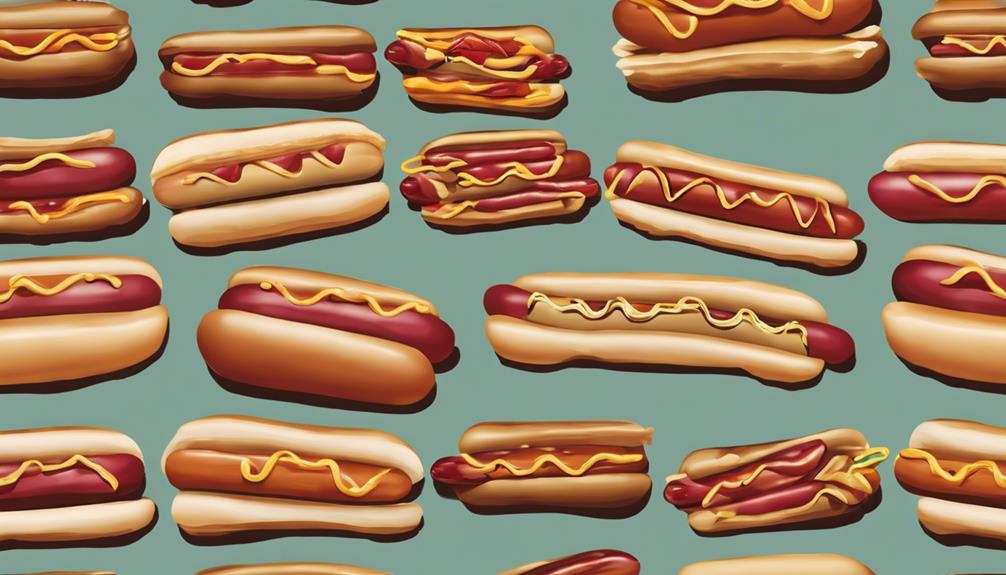
Limiting the quantity of hot dogs given to dogs is vital for maintaining their health and well-being. When it comes to hot dog treats, portion control is key. For very small dogs, it's best to stick to a single piece that's only 1/4-inch thick.
As the size of the dog increases, so can the serving size, with very large dogs able to handle up to half a hot dog. To guarantee your furry friend stays healthy, it's recommended to keep hot dog treats to no more than 10% of their daily calorie intake.
Hot Dog Alternatives for Dogs

For dog owners looking for healthier snack options, consider incorporating fruits and vegetables as nutritious alternatives to hot dogs in your pet's diet. Apples are a great choice as they're rich in fiber and vitamin C, promoting good digestion and a strong immune system. Carrots are another excellent option, providing fiber and beta-carotene for overall health and wellness. Green beans offer a crunchy snack packed with fiber and essential vitamins that dogs will enjoy.
Pumpkin is a fantastic substitute for hot dogs, high in fiber to support digestive health. Opting for these lean protein sources can help maintain your dog's well-being. By choosing these natural alternatives, you can provide your furry friend with a variety of nutrients that are essential for their overall health. Remember to introduce new foods gradually and in moderation to guarantee your dog's digestive system adjusts well to the change.
Expert Insights on Hot Dogs

After exploring healthier snack alternatives for dogs, it's vital to heed expert insights on the potential risks associated with feeding hot dogs to our furry companions. When it comes to hot dogs, there are several important factors to take into account:
- High Fat Content: DVM Renee Schmid warns about the high fat content in hot dogs, which can lead to stomach upset, diarrhea, and even heart disease in dogs. It's important to monitor the fat intake in your pet's diet to maintain their well-being.
- Choking Hazard: Hot dogs can pose a choking hazard for dogs due to their size and texture. Care should be taken to cut them into small, manageable pieces or avoid feeding them altogether to prevent any accidental choking incidents.
- Toxic Ingredients: Some hot dogs contain toxic components like onions or garlic, which can be harmful to dogs. Always check the ingredients list and avoid feeding hot dogs with harmful additives to keep your pet safe.
- Moderation: Experts recommend that treats shouldn't exceed 10% of a dog's daily calorie intake. It's important to incorporate hot dogs into your dog's diet in moderation to prevent potential health issues. Remember, moderation is key when it comes to feeding hot dogs to your furry friend.
Hot Dog Safety Tips for Dogs
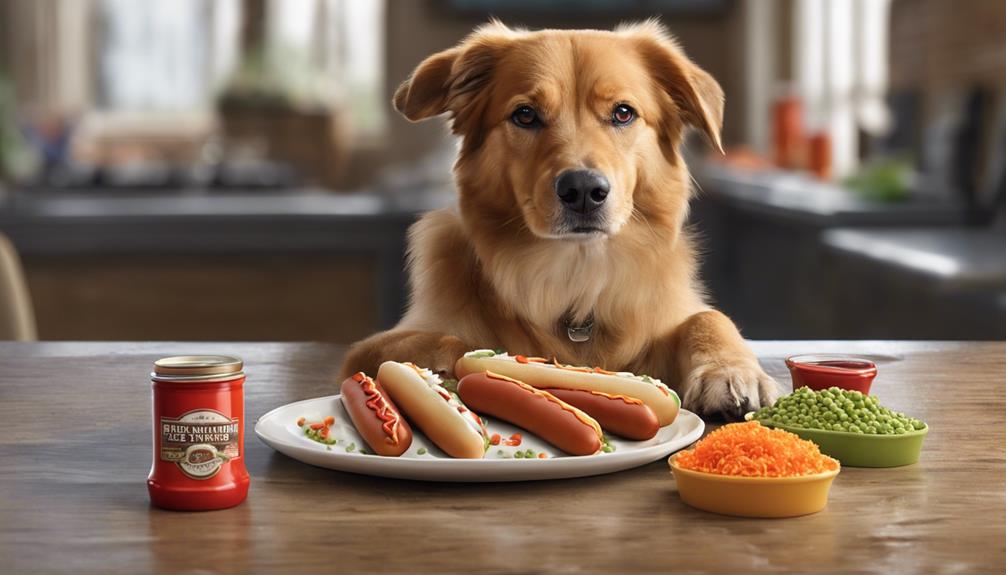
When feeding hot dogs to your furry friend, remember to cut them into small, bite-sized pieces to prevent choking.
Opt for hot dogs with natural ingredients and minimal preservatives for a safer snack.
Also, be cautious of the toppings you add, avoiding any that could be harmful to your pup's health.
Hot Dog Size
To ensure dogs' safety when consuming hot dogs, it's crucial to slice the hot dogs into small, bite-sized pieces to avoid choking hazards. When preparing hot dogs for your furry friend, make sure they're cut into manageable portions. Here are some tips to help you determine the appropriate size for your dog's hot dog treats:
- Avoid Whole Hot Dogs: Dogs might struggle with swallowing whole hot dogs, increasing the risk of choking.
- Small, Bite-Sized Pieces: Cutting hot dogs into smaller pieces makes it easier for dogs to chew and digest safely.
- Portion Sizes: Choose the right portion size based on your dog's weight for safe consumption.
- Supervision: Always supervise your dog while they eat hot dogs to prevent any potential choking incidents.
Cooking Method
For best safety when preparing hot dogs for dogs, we recommend boiling or grilling them without adding oil or seasonings. These cooking methods help maintain the hot dogs' natural flavors while ensuring they're safe for your furry friends to enjoy.
Remember to cut the hot dogs into bite-sized pieces, about ¼-inch thick, to prevent any choking hazards. Opt for hot dogs made with natural ingredients and minimal preservatives to promote safer consumption for your dogs.
By following these guidelines, you can treat your dogs to hot dogs as an occasional tasty reward during training sessions while keeping their diet healthy and balanced.
Enjoy preparing these delicious treats for your canine companions!
Toppings to Avoid
Let's avoid certain hot dog toppings to guarantee the safety of our furry friends, as some ingredients can be harmful to dogs.
Here are some toppings that are best kept away from your canine companion:
- Garlic and Onion: These ingredients are toxic to dogs and should never be included in their hot dog treats.
- Artificial Sweeteners: Be cautious of artificial sweeteners like xylitol, as they can be harmful to your dog's health.
- High Fat: Toppings with high-fat content can lead to digestive issues in dogs, so it's best to steer clear of them.
- Sodium Nitrate: This common ingredient in hot dog toppings can be harmful to your dog's well-being, so avoid it to keep them safe.
Frequently Asked Questions
Why Are Hot Dogs Safe to Eat Without Cooking?
Hot dogs are safe to eat without cooking because they're already processed and cooked during production. The ingredients are typically safe for dogs to consume as is.
Heating them can enhance the aroma and make them more appealing. Cold hot dogs can also be given, but some dogs may prefer them warmed up.
Serving hot dogs without cooking is convenient for quick treats or training rewards for dogs.
What Are 3 Foods Dogs Should Not Eat?
When it comes to foods that dogs should avoid, three significant ones are onions, grapes, and xylitol.
Onions can cause severe health issues like gastrointestinal problems and anemia. Grapes and raisins are known to lead to kidney failure, even in small amounts. Xylitol, often found in gum and candy, can cause a rapid drop in blood sugar and liver failure in dogs.
It's important to keep these harmful foods away from our furry friends for their well-being.
Are Any Hot Dogs Safe?
Hot dogs can be safe for dogs when chosen carefully. Look for lean options like chicken or turkey without onion, garlic, excess sodium, or preservatives. Opt for boiled or grilled hot dogs without added oils or seasonings.
What Are the 10 Toxic Foods for Dogs?
When it comes to toxic foods for dogs, there are several items to avoid. Chocolate can cause vomiting, diarrhea, and seizures. Grapes and raisins may lead to kidney failure. Xylitol found in gum and candy can lower blood sugar. Onions and garlic can damage red blood cells. Macadamia nuts may cause weakness and vomiting.
It's important to keep these items away from our furry friends to keep them safe and healthy.
Can Hot Dogs Cause Wisteria Poisoning in Dogs?
While hot dogs themselves are not toxic to dogs, they can still cause digestive issues if consumed in large quantities. Wisteria poisoning in dogs, on the other hand, is a serious concern. The toxic components in wisteria plants can lead to symptoms ranging from mild gastrointestinal upset to more severe complications.
Conclusion
To sum up, while hot dogs can be a tasty treat for dogs, it's important to bear in mind that they can pose risks if not served safely. A study found that 20% of dogs who consumed hot dogs with high sodium content experienced digestive issues.
By following safe serving methods, selecting the right types of hot dogs, and limiting the quantity given to your furry friend, you can guarantee they enjoy this snack without any harm. Remember, a little treat goes a long way!
